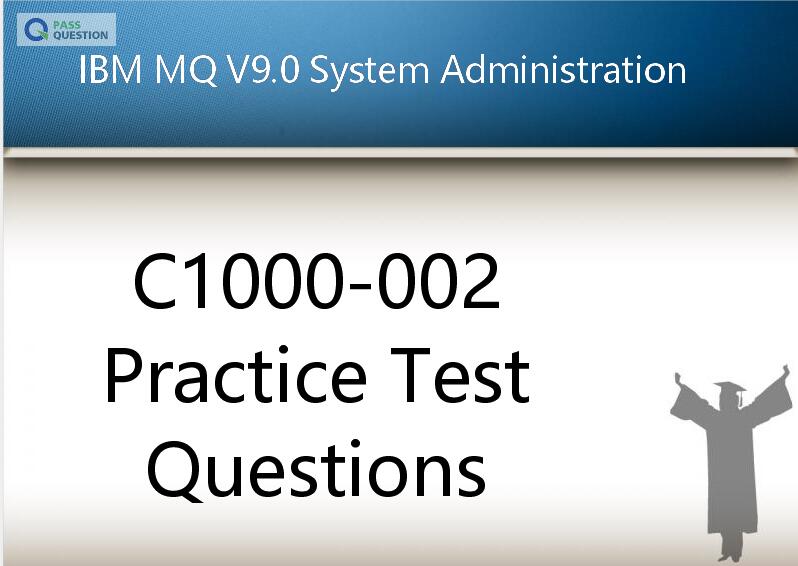C1000-002 Practice Test Questions - IBM MQ V9.0 System Administration
C1000-002 IBM MQ V9.0 System Administration exam is an important part of IBM certification and PassQuestion has the latest C1000-002 Practice Test Questions to prepare you for this test. Professionals with passed IBM C1000-002 Certification Exam are an absolute favorite in the industry. Obtain the PassQuestion C1000-002 Practice Test Questions and get a desired result with full confidence and ease. PassQuestion is surely the best choice for you to pass IBM C1000-002 with high scores.

C1000-002 Exam Overview - IBM MQ V9.0 System Administration
IBM Certified System Administrator - MQ V9.0 certification is for system administrators who have extensive product knowledge and are expected to plan, install, configure and maintain the product.It is expected that this system administrator will be generally self-sufficient and be able to perform the tasks involved in the role with limited assistance from peers, product documentation and vendor support services.
Due to the various platforms supported by IBM MQ V9.0, this certification is a cross platform certification. There are platform specific questions on the certification test. Due to the timing of the Continuous Delivery and Long Term Support availability on the appliance, questions related to MQ Appliance reflect version 9.0.1.
Exam Information
Exam Code: C1000-002
Exam Name: IBM MQ V9.0 System Administration
Associated Certification: IBM Certified System Administrator - MQ V9.0
Number of Questions: 65
Duaration: 90 Minutes
Passing Score: 70%
C1000-002 Exam Objectives
This exam consists of 8 sections described below.
Section 1 - Planning, Installation, and Migration 14%
- Describe the differences between Long Term Support (LTS) and Continuous Delivery (CD)
- Design an appropriate infrastructure to meet conflicting requirements
- Identify the pre-requisites for installing and implementing an IBM MQ configuration, including multi-instance queue managers
- Plan the appropriate backup and recovery strategy
- Describe the differences between MQ Advanced and MQ
- Select the appropriate IBM MQ platform for a given workload
- Outline migration considerations, including impact on existing applications and multi-installation
Section 2 - Configuration 17%
- Create the necessary IBM MQ objects to support an application
- Configure IBM MQ channels based on the network topology
- Configure IBM MQ objects for triggered applications and channels
- Create the objects required to enable queue manager clustering and workload distribution
- Predict the final destination of a message given a scenario containing alias or remote definitions
- Define the objects to support a publish/subscribe topology
- Configure IBM MQ objects to support JMS
- Configure channel exits
Section 3 - Security 14%
- Configure Channel Authentication (CHLAUTH)
- Understand the purpose of Connection Authentication (CONNAUTH)
- Control access to IBM MQ objects
- Configure IBM MQ channels with SSL/TLS
- Configure the IBM MQ client with SSL/TLS
- Describe MQ features that provide intrusion detection
- Distinguish between the available security choices
- Configure end-to-end message security
Section 4 - Administration 15%
- Administer queue managers and their objects
- Configure IBM MQ Explorer for remote administration
- Monitor and alter IBM MQ using the different command tools
- Define procedures to recover messages and objects in the event of failure
- Implement dead-letter queue handling
- Acquire and apply maintenance
Section 5 - Availability 9%
- Configure and manage a multi-instance queue manager
- Configure IBM MQ for automatic client reconnection
- Implement backup, restart and recovery procedures
- Implement a Queue-Sharing Group for high availability
- Manage an MQ cluster
- Configure and manage HA/DR for MQ appliance
Section 6 - Monitoring 9%
- Explain the IBM MQ capabilities for monitoring
- Enable and monitor IBM MQ events
- Monitor message and application activities
- Gather and analyze IBM MQ accounting and statistics data
- Use IBM MQ administration tools or commands to monitor the status of a queue manager, channel or queue
Section 7 - Performance Tuning 8%
- Identify the tools available to assist with IBM MQ performance
- Use accounting and statistical data to identify and resolve performance issues
- Tune IBM MQ object definitions for performance
- Tune client and server connection channel parameters
- Describe how to use the performance monitoring API
Section 8 - Problem Determination 14%
- Locate problem information such as IBM MQ error logs, FFST files and IBM MQ dumps
- Produce an IBM MQ trace
- Identify the steps to evaluate and recover a non-responsive queue manager
- Identify and solve security issues with a user, application, or channel
- Determine the route that a message took through a queue manager network
- Describe how to use the Enhanced Application Activity Trace
- TOP 50 Exam Questions
-
Exam
All copyrights reserved 2025 PassQuestion NETWORK CO.,LIMITED. All Rights Reserved.

